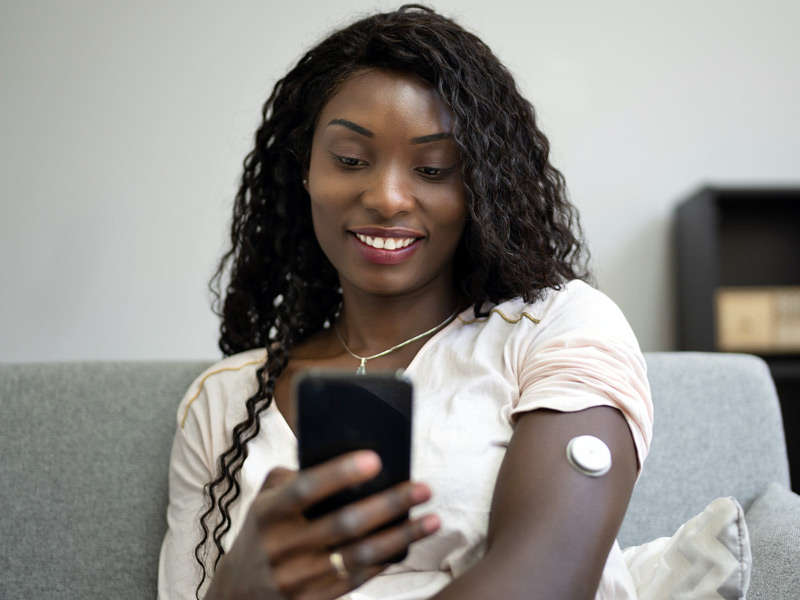New CGM Resources Help You Provide State-of-the-Art Care
Explore Tools to Support Patients in Managing Their Diabetes
Jan. 5, 2023, 3:40 p.m. News Staff — The benefits of using continuous glucose monitoring to help certain patients with diabetes achieve recommended glycemic targets are significant: It can provide robust information about average glycemic levels and glucose variability while reducing and, in some cases, completely eliminating the need for fingerstick glucose testing.

That’s a win-win for patients and physicians.
If you’re not up to speed on the many ways CGM can support you and your patients in managing their diabetes effectively, the AAFP has you covered. The Academy has assembled a comprehensive collection of CGM resources and tools — some new, others tried and true — designed to help you feel confident navigating the complexities of prescribing and ordering the right CGM system to suit each patient’s needs. And you can access them all from a single aafp.org webpage.
Patients, of course, play an integral role in successful diabetes management, and monitoring blood glucose is an essential component of the care regimen. To help patients learn about this process, consider steering them to recently updated information on familydoctor.org, including new resources specifically focused on CGM.
All of these new CGM resources have been supported by an educational grant from Abbott Diabetes Care.
Story Highlights
Resources for Members
Need help getting started with prescribing and ordering CGM? AAFP TIPS™ Continuous Glucose Monitoring: Enhancing Diabetes Care, Workflows, Education, and Payment will walk you through the entire process. In this course, you’ll learn how to
- identify patients who would qualify for and benefit from CGM,
- determine whether you and your patient think personal or professional CGM would be the best fit,
- evaluate patients’ readiness to incorporate this technology into their diabetes management regimen,
- interpret CGM data and
- use it to inform treatment.
Expert family medicine faculty will share their knowledge and experience during this comprehensive CME session, which also includes both physician- and patient-focused resources ready to download. Plus, you can earn up to 2 Prescribed credits through April 15, 2023.
In addition, the new page features Family Medicine: CGM in Your Practice videos that explore various aspects of using CGM in patient care.
- In a video that discusses implicit bias, you’ll explore factors that may influence your decision to pursue CGM with a patient and learn how to ensure you are providing equitable care when it comes to this technology.
- A second video aims to help you understand important CGM data measures and how to engage with patients in shared decision-making to make diabetes care adjustments based on that data.
- And in a third video, you’ll be introduced to professional CGM and how to implement it into your practice.
An extensive section of the page outlines elements of ordering personal CGM according to patients’ insurance status (i.e., those covered by Medicare, Medicaid or private plans, as well as patients without CGM coverage). Topics include eligibility requirements, documentation specifics (including sample chart notes), ordering details for each available brand of device and authorization needs.
And if personal CGM isn’t the right fit — say, for patients who don’t have insurance that will cover it — there’s an entire segment that discusses professional CGM, including how to implement it in your practice, interpret and act on the data received, and bill for it.
Resources for Patients
Getting buy-in from your patients with diabetes is critical to successfully engaging them in self-management. You can start by educating them about the importance of monitoring their blood sugar at different times of the day on an ongoing basis and the options available to do so.
A recently updated familydoctor.org article, “Monitoring Your Blood Sugar Level,” can help by discussing those options — hemoglobin A1c testing every three months, daily testing using a blood glucose monitor and CGM — and their respective pros and cons. Other topics addressed include what patients should do if they experience hypoglycemia or have an insulin reaction, as well as questions they may wish to ask their physician.
Finally, the article offers three new videos featuring a patient who uses CGM:
- “Patient Experience with CGM”: This video introduces Mila Clarke, a patient with latent autoimmune diabetes who founded the diabetes blog HangryWoman.com in 2016. In the video, Clarke shares her experience using CGM for the past four years.
- “FAQ and Demo”: Patients frequently have many questions when they first learn about CGM. In this video, Clarke explains the basics of CGM and demonstrates how she applies her CGM sensor device and connects it to her smartphone or reader.
- “Understanding Your CGM Data”: Clarke walks patients through the data they can expect to see on their CGM reader or smartphone and offers basic information about what that data means and how she and her physician interpret and act on it.